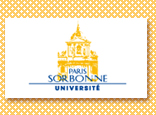| Integration
of subject and IT |
 |
IT skills and
notions introduced |
 |
Hyperdocuments
used : description of their interface |
| |
|
|
|
|
When you study the universities
in the 18th c, you should study both their intellectual
history and that of their architectural development
1) The scientist
Newton, whose discoveries in optics (the spectrum) influenced
the literary and artistic imagination, and who also discovered
the law of gravitation
2)
The architect Wren in Oxford and Cambridge in the late
17th c: eg. the Library of Trinity College, Cambridge
|
|
|
1)
Type http://www.ox.ac.uk
then look for the Bodleian Library, which has an
index of websites classified by subject
2) Portals
are sites which open lists of other websites on similar
topics : the online equivalent of bibliographies
3) The
URL are active: you only need to click on it to
be transferred to the website |
|
|
|
| |
|
|
|
|
Creating your own presentation
|
|
|
And now you will not stop at using
multimedia resources made by your predecessors, you can
go on to create your own multimedia
resources.
1) Creating a Powerpoint presentation:
open "Démarrer / Programmes / Powerpoint".
2) You will create the title page, with the layout automatically
offered : write "Universities in the 18th century"
3) You will then create a series of transparencies, clicking
on the menu "insérer / nouvelle diapositive"
each time you wish to create a new one.
 You
will then be offered a list of options for the layout
of the new transparency: You
will then be offered a list of options for the layout
of the new transparency:
- bullet list
- illustration and legend, or legend and illustration
… in horizontal or vertical disposition.
You will use the bullet lists for tables of topics, such
as : the history of the universities - the main 18th c.
academic buildings - the most famous scientists…
|
|
|
Powerpoint presentation
See the tutorial "Premiers pas sur Powerpoint"
« Powerpoint, un outil pédagogique » on the e-cursus website :
http://www.e-cursus.paris4.sorbonne.fr / Liste des cours / Informatique et bureautique / Sabrina Menasri
A Ppt presentation may be used to present your papers
in seminars; it allows you to outline your argument and
integrate into it the documents you have gathered on your
research topic.
|
|
| |
|
|
|
|
Saving images for your presentation
|
|
|
4) For
the illustrations: you will need to save
images (warning: you may use images copied from
a website only for private research, you may not publish
them on your own website without seeking permission).
 Leaving
the Ppt presentation for a moment, open the Internet;
on the Oxford or Cambridge website, click with the right-hand
button of the mouse on a photograph of an 18th c. building
you wish to include in your presentation, and in the contextual
menu which appears click on "Enregistrer comme",
giving the image a name and a folder location Leaving
the Ppt presentation for a moment, open the Internet;
on the Oxford or Cambridge website, click with the right-hand
button of the mouse on a photograph of an 18th c. building
you wish to include in your presentation, and in the contextual
menu which appears click on "Enregistrer comme",
giving the image a name and a folder location
 You
will then include this image in your presentation by going
to the folder where you have saved it, opening it, copying
it and returning to your Powerpoint presentation to paste
it in a transparency (for which you have selected a layout
including a place for an image). You may also return directly
to the Ppt presentation, and take the menu "Insérer/
Image", then browse for the image you have saved You
will then include this image in your presentation by going
to the folder where you have saved it, opening it, copying
it and returning to your Powerpoint presentation to paste
it in a transparency (for which you have selected a layout
including a place for an image). You may also return directly
to the Ppt presentation, and take the menu "Insérer/
Image", then browse for the image you have saved
|
|
|
|



